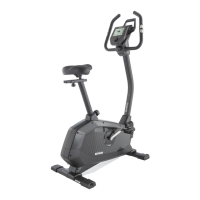
Do you have a question about the Kettler GIRO S3 and is the answer not in the manual?
| Gear ratio | 1:8 |
|---|---|
| Drive system | Ribbed belt |
| Product type | Upright bicycle |
| Product color | Anthracite, Black |
| Resistance system | Magnetic |
| Saddle adjustment | Vertical/Horizontal |
| Number of programs | 6 |
| Maximum user weight | 130 kg |
| Performance monitor | Yes |
| Resistance adjustment type | Manual |
| Number of resistance levels | 15 |
| Training displayed parameters | Average speed, Calories, Distance, Evolutions per minute (RPM), Heart rate, Speed, Time |
| Optional heart rate measurement | Chest belt |
| Standard heart rate measurement | Hand grip sensors |
| Display type | LCD |
| Power source | AC |
| AC input voltage | 230 V |
| Depth | 1050 mm |
|---|---|
| Width | 600 mm |
| Height | 1360 mm |
| Flywheel weight | 8000 g |
Essential safety guidelines for using the exercise equipment, including warnings and precautions.
Instructions on how to properly use and maintain the exercise equipment to prevent damage and ensure longevity.
Reference to the list of available spare parts for ordering.
Guidance on how to dispose of KETTLER products responsibly and environmentally.
Important safety information for users, including warnings for children and during assembly.
Guidelines for the proper use of the fitness equipment, emphasizing domestic use.
Critical safety warnings and precautions for operating the fitness equipment.
Instructions on the correct usage of the apparatus, focusing on domestic settings.
How to order spare parts, including required information like article and serial numbers.
Advice on the proper disposal and recycling of KETTLER products.
Specifies the required safety distance of 1 meter around the training area.
Details for the first assembly phase, including screw sizes and torque.
Instructions for attaching the handlebars and connecting cables.
Steps for mounting the console and securing the handlebars.
Instructions for connecting the main frame components and pedals.
Finalizing the console mounting and securing related parts.
Instructions for installing the saddle and seatpost, including adjustment mechanisms.
Checking the rotation of the pedals and ensuring smooth operation.
Finalizing cable connections and ensuring the overall stability of the assembled unit.
Notes that replacement parts may exhibit slight color differences from the original.
Explains the benefits of the hometrainer for joint-friendly, cardiovascular, and fat-burning training.
Guides on adjusting seat height and saddle-to-handlebar distance for optimal posture.
Instructions on how to adjust the handlebar angle for comfortable positioning.
Describes different ways to use the hometrainer to target specific muscle groups.
Advice on pre- and post-exercise stretching to prevent injuries and muscle soreness.
A structured 4-week training schedule for new users of the hometrainer.
How to adjust the seat height for proper posture and effective, joint-friendly training.
Detailed steps for setting the correct seat height for optimal pedaling and comfort.
Instructions for horizontally adjusting the saddle position relative to the handlebars.
Guidance on adjusting the handlebar tilt for a comfortable and effective training posture.
General advice on training, including stretching and listening to your body.
Introduction to the exercise bike, highlighting its benefits for joint health and cardiovascular training.
How to set the optimal saddle height to ensure proper leg movement and joint protection.
Adjustment of the saddle's horizontal position for personalized comfort and fit.
Steps to adjust the handlebar angle for an ergonomic and safe training position.
Techniques to increase workout intensity and target specific muscle groups.
Reminders about stretching exercises to prevent injuries and muscle soreness.
Overview of the hometrainer, focusing on joint-friendly cycling and cardiovascular benefits.
Key advantages of the hometrainer, including ergonomic adjustment and low joint impact.
Guidance on achieving the ideal body posture for effective and comfortable training.
Introduction to the static bike, emphasizing its suitability for cycling enjoyment and joint care.
Advantages such as ergonomic adjustment, cardiovascular training, and space-saving design.
How to adjust the saddle height for optimal pedaling and protection of joints.
Instructions for horizontally adjusting the saddle for a personalized fit.
Guidance on adjusting the handlebar angle for ergonomic comfort.
Methods to intensify workouts and engage different muscle groups during cycling.
Important advice on pre-exercise stretching to prevent injuries and post-exercise recovery.
Overview of the home trainer for cycling enthusiasts wanting to avoid joint strain.
Key benefits including ergonomic adjustment, cardiovascular benefits, and low joint impact.
How to adjust the bike for the ideal posture, ensuring comfort and joint protection.
A list of all available spare parts with their corresponding article and part numbers for ordering.
A list of all available spare parts with their corresponding article and part numbers for ordering.